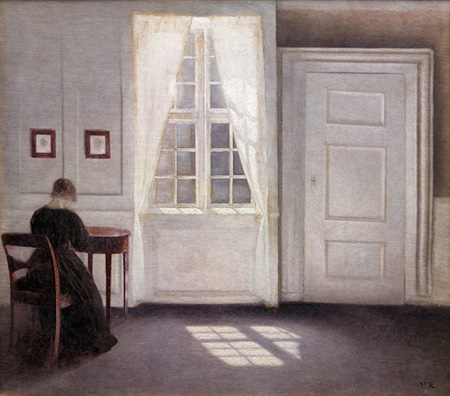
Continuing through September 25, 2016
The life and career of Danish artist Vilhelm Hammershøi (1864-1916) are a good example of the “wrong place, wrong time” phenomenon in the art world. Several great artists of the past — Vermeer, Rembrandt, Joseph Cornell to name a few — have undergone notable posthumous upgrades of their reputations. Hammershøi’s death centennial is the occasion for “Chronicles of Solitude.” As National Gallery of Denmark curator Kasper Monrad points out in the catalogue, since the 52-year-old artist’s premature death from cancer, his fortunes rose and fell — and have risen again. At first, the new director of the National Gallery liked his work; his father-in-law was Hammershøi’s greatest patron, so numerous acquisitions and loans were made. However, the succeeding director in 1930 preferred Matisse and the School of Paris: loans were returned and no new paintings were acquired for years. Hammershøi’s reputation declined precipitately. Only in the 1950s were his fortunes — and additional paintings — rescued when museums in other countries such as Great Britain, France, Germany, Japan and the U.S. requested loans and exhibitions of his work.
Why was he so vilified during his lifetime? As the 25 interiors, landscapes, portraits and architectural scenes affirm, his art was resolutely quiet, radically eschewing the naturalism, realism and chromaticism of his colleagues. For example, two of his best friends, the Henningsen brothers, were acclaimed for their scenes of funeral processions and the newly evicted homeless. Social and political subjects reigned in Copenhagen. With his ardently non-psychological portraits, narrow palette, and resistance to topical subjects, Hammershøi was repeatedly rejected from the annual academy salons — that is, until he began winning prizes in Paris for paintings that had already been turned down at home.
Using rooms in his own apartment, family and friends as subjects, Hammershøi burrowed deeply into emptiness, absence and nothingness. “Interior: An Old Stove” (1888), “Sunlight on the Floor” (1901) and “Artificial Light” (1909) chronicle the solitudes of urban existence. Without people or even much furniture, they focus on thin northern sunlight without a whiff of French Impressionism or German Expressionism. Ever the outlier, the Dane preferred corners of rooms to middle-class living quarters; edges of forests to any grand vista; and ghost-like apparitions or still lifes that were admired in Paris by Swiss poet Rainer Maria Rilke and novelist Marcel Proust. If only Rilke had lived long enough to write his planned book on the Danish artist. And what if Proust had included Hammershøi in his masterpiece, “In Search of Lost Time” (1913-1927)? Vuillard and Vermeer are really the only artists to whom Hammershøi can be compared, although John Singer Sargent was a great admirer and one can detect a whiff of Danish influence in some of his art.
There is a satisfying ambiguity to all of Hammershøi’s art that is very modern. What is their subject or theme? People, but not personalities. Nature, but without any warmth or grandeur. What is their appeal? An artist’s artist, Hammershøi was so independent and set in his ways that he seemed to ignore the art world, all of which hurt him in Copenhagen but helped him in the more worldly capitals, to which he and his wife, Ida (whom he painted many times), travelled regularly. With a new re-hang of the Frye’s permanent collection steps away, visitors can see the pompous tableaux of contemporaneous Austrian, German and Scandinavian artists against whom he quietly rebelled.
Curator Monrad shies away from characterizing Hammershøi as predating modern art, but other historians have credited his minimal compositions, narrow palette (black to white with in-between tones), and isolated, if not alienated, people, as anticipating mid-20th-century developments. Similarly, the interior scenes, so sparse and simplified, presage modern Scandinavian and German domestic environments of the 1950s and 1960s, i.e., what we now call Danish Modern.
Time and light are Hammershøi’s themes, the way each denotes and calibrates how light on a wall or floor tells the time of day or conveys its recession into darkness and silence. Figures in “Evening in the Dining Room” (1891) never communicate with one another. His artist-pal portraits reveal little inner life but capture a mood of professional cooperation. In “Interior with Mirror” (c. 1907), we stare into a bedroom corner through a doorway flanked by a mirror and demi-lune side table. It could be early morning on a lazy weekend. With the empty mirror, we grasp at a possible symbol of the artist, reflector of light and the passage of time. In this sense, Hammershøi proved ultimately to be in the right place, just destined for the right time to be considerably later.
